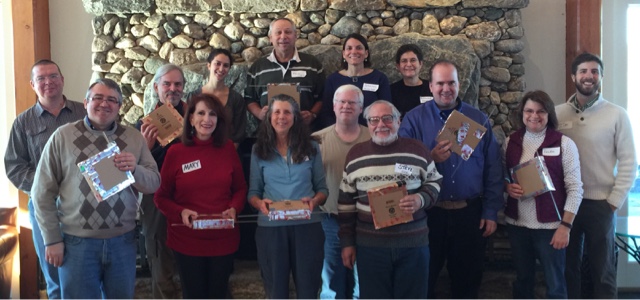 |
| Spectroscopy Day at the NEACT Meeting at Pomfret School, December 5th 2015 |
 |
| Sandy tapes her pizza box closed to remove light noise |
I led the teachers through the project in the same way that I do this lab with my students. They traced the template onto their own pizza box, cut out the necessary holes, and assembled the boxes. Once the boxes were built, they calibrated them with the mercury lamp.
 |
| Josh checking the light leaking into his box, and Steve folding up the pizza box (not as easy as it looks). |
 |
| Mike and Helaine are putting the finishing touches on their spectroscopes |
 |
| Tim Rose, my colleague at Pomfret School, came out to help with the spectroscope project. |
After we finished working with our spectroscopes, we took some time to discuss the project and possible road blocks to completing the project with their students. The razor blades were the first thing that many of the teachers raised as a road block. One of the teachers used two pieces of tape to make a slit for the light on his box, another teacher suggested using old gift cards to create the clean edge for the light slit. The second road block that several teachers brought up was access to atomic spectrum lamps. Many of the teachers don't have access to the gas tubes and lamps to calibrate the spectroscopes. One teacher suggested using colored LEDs with known wavelengths to calibrate the boxes. There was some question about using the mercury gas tubes in schools. Most schools have banned all mercury in the science labs, even a mercury emission tube with a tiny amount of it enclosed in glass. Some schools still use fluorescent lights with mercury, these make a good light source for the calibration. Another teacher shared a plastic version of the gas tubes that she has in her lab that is less likely to break. I enjoyed taking time to discuss the project with experienced chemistry teachers from a wide range of schools.
 |
| Front row: (left to right) Pedro, Mary, Sandy, Jim, Steve, Kevin, Leslie, Tim Second row: (left to right) Calin, Mike, Micaela, Ed, Sharon, Helaine |
The second half of the program was dedicated to the connection between astronomy and chemistry. Josh Lake, our astronomy teacher here at Pomfret School, gave a talk about the development of spectroscopy in relation to discoveries in astronomy. Josh walked us through the use of spectroscopy in astronomy, highlighting the major developments and main players in the progression. A lively discussion accompanied his talk, with teachers asking and answering questions along the way.
We finished the program with a tour of the Pomfret School observatory. Josh drove the group in one of our short buses (know as "toasters" on campus) to the observatory for a quick look at our facility. We enjoyed lunch together in the dining hall to wrap up the day.
 |
| Josh leading a lively discussion with the group about spectroscopy applications in astronomy. |
Link to PPT Show (58 MB is the compressed size, it was 250 MB originally!):
Spectroscopy Atlas: http://www.ursusmajor.ch/downloads/spectroscopic-atlas-5_0-english.pdf (PDF)
Hubble’s Law Lab: http://www.astro.washington.edu/courses/labs/clearinghouse/labs/HubbleLaw/galaxies.html
Hubble Ultra Deep Field Video: https://www.youtube.com/watch?v=oAVjF_7ensg



No comments:
Post a Comment